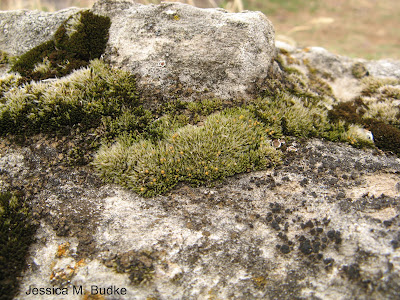Introducing Jaffueliobryum wrightii! Finally I finished up my moss identifications from my field trip to Missouri and Kansas back in March. This is why I don't do much collecting. My collections tend to sit around for quite a while before identifying them makes it to the top of my list of things to do. And unless I have time for identifying them the mosses are best left growing in the wild.
So Jaffueliobryum wrightii is in the moss family Grimmiaceae. A telling feature is that the leaves have long, white awns at the tips. Thus, I jumped directly to the Grimmiaceae for my identifying. The genus Jaffueliobryum is usually found on calcareous rocks. This population was growing on sandstone. It doesn't really have a common name, but the genus was named for Félix Jafuell, a clergyman who collected plants in South America. There are only 3 species in North America. One only in Mexico and the other two are widely distributed across the western United States. So once I identified it to Jaffueliobryum there were only two species to choose from. The other species, Jaffueliobryum raui, has keeled leaves (the same idea as the keel on a boat, they look folded or have a ridge down the center), which can be easily seen after making a leaf cross-section. Since this sample did not have keeled leaves, it was Jaffueliobryum wrightii.
It was a really fun plant to identify and I'm glad I got the chance to spend some time with it under the microscope. Now off to the herbarium this sample goes.


















Hi Jessica,
ReplyDeleteI'm trying to identify some mosses for a project I'm working on. Your blog came up first in a search for "mosses of connecticut." Do you think you can you point me in the direction of a good field guide for connecticut mosses? I tried using the one at life.illinois.edu, but I'm not an expert on mosses (or plants in general), so I'm looking for something a bit simpler. Appreciate any help you could give me!
- Paul
BTW, I noticed you're in the EEB department at UCONN. Do you know Kat Shaw?
Hi Paul,
ReplyDeleteThere really aren't any field guides specific to Connecticut. A couple of books that will assist in identifying some of the common genera are
- Davison, P. G. with M. J. Pistrang. 2008. A Trailside Guide to Mosses and Liverworts of the Cherokee National Forest. Published online < http://www.blurb.com/books/422248>
- Munch, S. 2006. Outstanding mosses and liverworts of Pennsylvania and nearby states.
Both of these books have a large number of photos and descriptions that help with identifying the mosses and liverworts to genus.
However, if you are interested in a dichotomous key that will help you identify the plants to species you might try the Bryophyte Flora of North America online.
BFNA = http://www.mobot.org/plantscience/bfna/treatments.htm
Also this book has a good key to many of the common North American Genera that are found in Connecticut. - Crum, Howard. 1983. Mosses of the Great Lakes Forest, 3rd edition. University of Michigan Herbarium: Ann Arbor, Michigan.
I also use Crum and Anderson's Mosses of Eastern North America two volume set a lot.
It just depends on what level of detail you are looking for. Hope that was helpful. And yes I know Kat Shaw. She is a PhD student in the department studying stickleback fish.
Best - Jessica
Thank you!
ReplyDeleteBased on the Davison Trailside Guide, I think I've got our first sample narrowed down to an Atrichum species, perhaps A. undulatum. I never realized that there were so many kinds of moss!
Kat and I TA'd BIO107 together when I was at UCONN. I used to know a bunch of other EEB folk, but I don't remember most of them anymore.
Thanks again!
- Paul